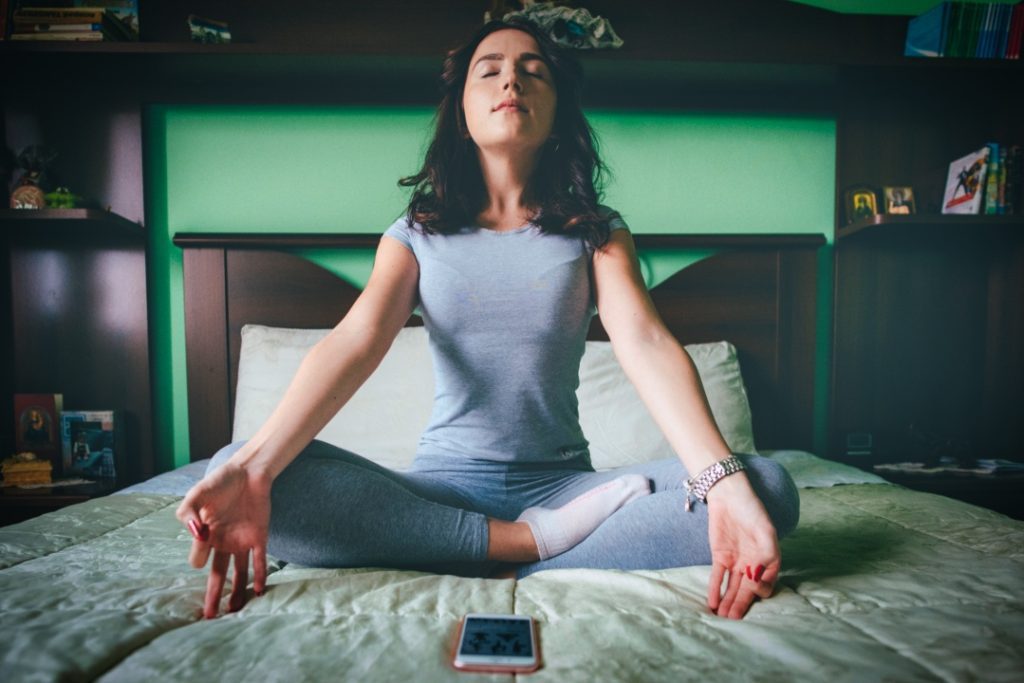A 5-Minute Guide to Bedtime Meditation

Even if you’re careful about sticking to a regular bedtime, you may need to do more than that to get a restful night’s sleep. Otherwise, you could be lying still in your bed, but you’re still wide awake because your mind is racing.
Meditation could be the answer if concerns about your health, finances, or other issues are keeping you up.
Mindfulness practices can increase the quality and quantity of your sleep. Learn how to make bedtime meditation work for you.
Preparing for Bedtime Meditation
Create an environment and mindset conducive to contemplation. Preparing for bedtime meditation is similar to preparing for sleep in many ways.
Doing these activities will help you wind down:
1. Slow down. If you’ve been rushing around much of the day, relax and quiet your mind. Put aside stressful subjects and tasks. Read a book or work on a soothing hobby.
2. Turn off devices. Bright screens and action movies stimulate your brain, making it harder to fall asleep. Power down your phone and computer.
3. Block out noise. What about noisy neighbors and car alarms? Turn on a fan or put in your ear plugs.
4. Eat light. Heavy meals and spicy food can also make it difficult to drift off. If you need a snack, make it small and nutritious, like a handful of nuts or a glass of warm milk.
5. Draw a bath. Soaking in a warm tub is a great way to relax. It will also raise your body temperature, which helps to prepare you for sleep.
6. Dress comfortably. Sleep and meditation call for similar wardrobe choices. Wear loose-fitting pajamas or other soft clothing made from natural fibers.
Methods and Subjects for Bedtime Meditation
You may be used to staying alert during daytime meditation. However, it’s okay to give yourself permission to fall asleep during your nighttime sessions.
Try these ideas for easing yourself into pleasant dreams:
1. Scan your body. Explore your body from head to toe. Check for any areas of tension that you can release by imagining that you are bathing them in warm and healing light.
2. Listen to podcasts. Guided meditation can be especially useful for beginners. Browse online for resources like the Plum Village app or Headspace.
3. Follow your breath. Your meditation can be as simple as focusing on your breath. Inhale through your nose. Feel the air filling and lifting your stomach and chest. Relax and release the air gently through your mouth.
4. Chant and sing. Find a mantra to repeat silently or out loud. Invent your own wording or read some inspirational literature for ideas.
5. Learn yoga nidra. There’s a style of yoga just for sleep. Yoga nidra literally means yogic sleep, and it describes a state between wakefulness and sleep. Take classes at a local studio or online to master the techniques.
6. Pick an object. Placement meditation can help you to calm your thoughts by holding your attention on an idea or mental image. If your mind wanders, gently bring it back. You’ll gradually build your concentration and feel more peaceful.
7. Express gratitude. There are many beneficial objects you can choose from for placement meditation. Thankfulness is an excellent choice for bedtime. Review your day to remember the acts of kindness you received and generate warm and happy feelings.
8. Practice your faith. Meditation is a tool that can be used to practice any kind of religious, spiritual, or personal beliefs. Adapt your bedtime rituals to serve your own purpose and needs.
Fall asleep faster and stay asleep longer with a bedtime meditation practice. Your nights will be more peaceful, and your days will be more restful when you use mindfulness to increase your mental and physical wellbeing.
CLICK HERE to Explore Our Free Online Courses


Responses